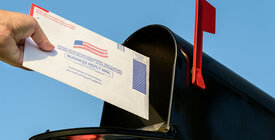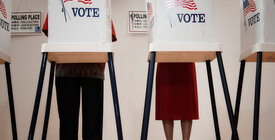Fact: Vote-counting machines are more accurate than hand counts when it comes to large numbers of ballots. After the machine count is complete, election officials audit paper ballots to verify the accuracy of machine counts.
Nearly all election jurisdictions across the country use voting machines to count ballots because they are more accurate, faster, and cheaper than counting all ballots by hand. In fact, all voting machines certified by the U.S. Election Assistance Commission must pass tests requiring them to accurately count at least 10 million votes. Voting machines produce comprehensive records that election officials use to verify results through multiple layers of review. To further ensure accuracy, election officials in most states verify these electronic totals by reviewing some ballots by hand and comparing these results to machine counts.
Hand counts fail when there are large numbers of ballots because humans are bad at tedious and repetitive tasks — the exact jobs computers are designed for. In a recent attempt to count ballots by hand, election workers initially counted one of every four ballots incorrectly — meaning the results were off by 25 percent, a discrepancy that can lead to the wrong candidate winning. Election officials routinely test voting machines before and after elections to ensure they are counting ballots correctly.
Hand counts are not only less accurate, they take more time than machines, which delays election results. And they cost taxpayers more. One county of 111,000 voters estimated that a hand count would cost over $1.6 million and require hiring 1,200 additional staff members — and the process would take 18 days.
Finally, while certain other countries may hand count ballots, they typically have one or two contests per election. In the United States, a single ballot may contain dozens of races, making it much more difficult to hand count ballots.
Rumor: Vote-counting machines cannot be trusted and counting ballots by hand would produce accurate results.
Vote-counting machines are complex, and the public is largely unaware of the safeguards in place to ensure the machines consistently produce accurate results. Bad actors have exploited these knowledge gaps to claim that counting ballots by hand is the only way to ensure election results are accurate, when in fact hand counts can have error rates up to 50 times higher than vote-counting machines. Only a handful of very small counties — typically with fewer than 1,000 voters — have the resources to conduct accurate hand counts.
• • •
We worked with Swayable, a research software platform that measures how effectively media content changes opinions, to determine what messages helped voters best understand the facts.
Suggested counter-messages based on our testing:
- Election officials audit all machine counts by hand to ensure that ballots are counted promptly and accurately.
- Vote-counting machines create comprehensive records of all votes so these votes can be audited. This helps ensure that ballots are counted promptly and accurately.
The messages above were found to be most effective in communicating the facts, though differences exist by region and demographic group. See Swayable’s dashboard to examine more detailed results, including other messages tested.



